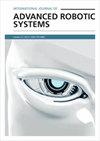婴儿图式效应对社交机器人面孔可爱度和可信度的影响研究
IF 2.1
4区 计算机科学
Q2 Computer Science
International Journal of Advanced Robotic Systems
Pub Date : 2023-05-01
DOI:10.1177/17298806231168486
引用次数: 1
摘要
以低成本、高效的方式探索人们对社交机器人外观设计的态度,增强人机交互体验,一直是机器人开发人员和交互设计师关注的话题。本研究旨在通过两个实验探讨婴儿图式效应对用户对社交机器人人脸的可爱度和可信度的影响。实验1使用100张真实世界中经过统一处理的机器人人脸图片来帮助探索婴儿脸的可爱程度和可信度之间的线性关系,并通过互联网共收到98份有效问卷。实验2是一个5×3的受试者内部析因设计。研究变量为机器人类型(即MAKI、RoboThespian、Flobi、Pepper和iCat)和婴儿模式(低模式、非控制模式和高模式);调查了它们对用户可爱度和可信度的影响。通过互联网共收集了175份有效问卷。研究结果如下:(1)社交机器人人脸的娃娃脸程度和感知情绪对大多数真实世界机器人的可信度有积极影响。(2) 本研究从定量的角度获得了娃娃脸、可爱度和可信度的相关公式,从而为通信机器人的相关可信度研究提供了参考。(3) 一般来说,婴儿图式效应也存在于大多数真实世界机器人的可爱度评估中。具有高模式的人脸被认为比不受控制或低模式的人脸更可爱、更值得信赖。(4) 机器人类型和婴儿模式与可爱度和可信度有显著的交互作用。(5) 然而,对于某些类型的机器人,婴儿模式效应也可能产生反作用,即过高的婴儿模式可能会降低用户对社交机器人可爱度和可信度的感知。本文章由计算机程序翻译,如有差异,请以英文原文为准。
Research on the influence of the baby schema effect on the cuteness and trustworthiness of social robot faces
Exploring people’s attitudes toward the appearance design of social robots in a low-cost and efficient way, and enhancing the experience of human–robot interaction have always been topics of concern for robot developers and interaction designers. This study aimed to explore the influence of the baby schema effect on users’ perceptions of cuteness and trustworthiness pertinent to social robot faces through two experiments. Experiment 1 used 100 uniformly processed pictures of robot faces in the real world to help explore the linear relationship among the degree of baby face, cuteness, and trustworthiness, and received a total of 98 valid questionnaires via the Internet. Experiment 2 was a 5 × 3 within-subjects factorial design. The research variables were robot type (i.e. MAKI, RoboThespian, Flobi, Pepper, and iCat) and baby schema (low schema, uncontrolled, and high schema); their impact on users’ perceptions of cuteness and trustworthiness was investigated. A total of 175 valid questionnaires were collected via the Internet. The generated results are as follows: (1) The degree of baby face and perceived emotion of social robot faces had a positive impact on trustworthiness for most real-world robots. (2) This study obtained the correlation formula of baby face, cuteness, and trustworthiness from a quantitative point of view, thus providing a reference for research on the related credibility of communication robots. (3) In general, baby schema effect also existed in the cuteness evaluation of most real-world robots. Faces with high schema were considered cuter and more trustworthy than uncontrolled or low schema faces. (4) Robot type and baby schema had a significant interaction with cuteness and trustworthiness. (5) However, for certain types of robots, baby schema effect may also have a counter-effect, that is, an overly high baby schema may reduce users’ perceptions of the cuteness and trustworthiness of social robots.
求助全文
通过发布文献求助,成功后即可免费获取论文全文。
去求助
来源期刊
CiteScore
6.50
自引率
0.00%
发文量
65
审稿时长
6 months
期刊介绍:
International Journal of Advanced Robotic Systems (IJARS) is a JCR ranked, peer-reviewed open access journal covering the full spectrum of robotics research. The journal is addressed to both practicing professionals and researchers in the field of robotics and its specialty areas. IJARS features fourteen topic areas each headed by a Topic Editor-in-Chief, integrating all aspects of research in robotics under the journal''s domain.

 求助内容:
求助内容: 应助结果提醒方式:
应助结果提醒方式:


